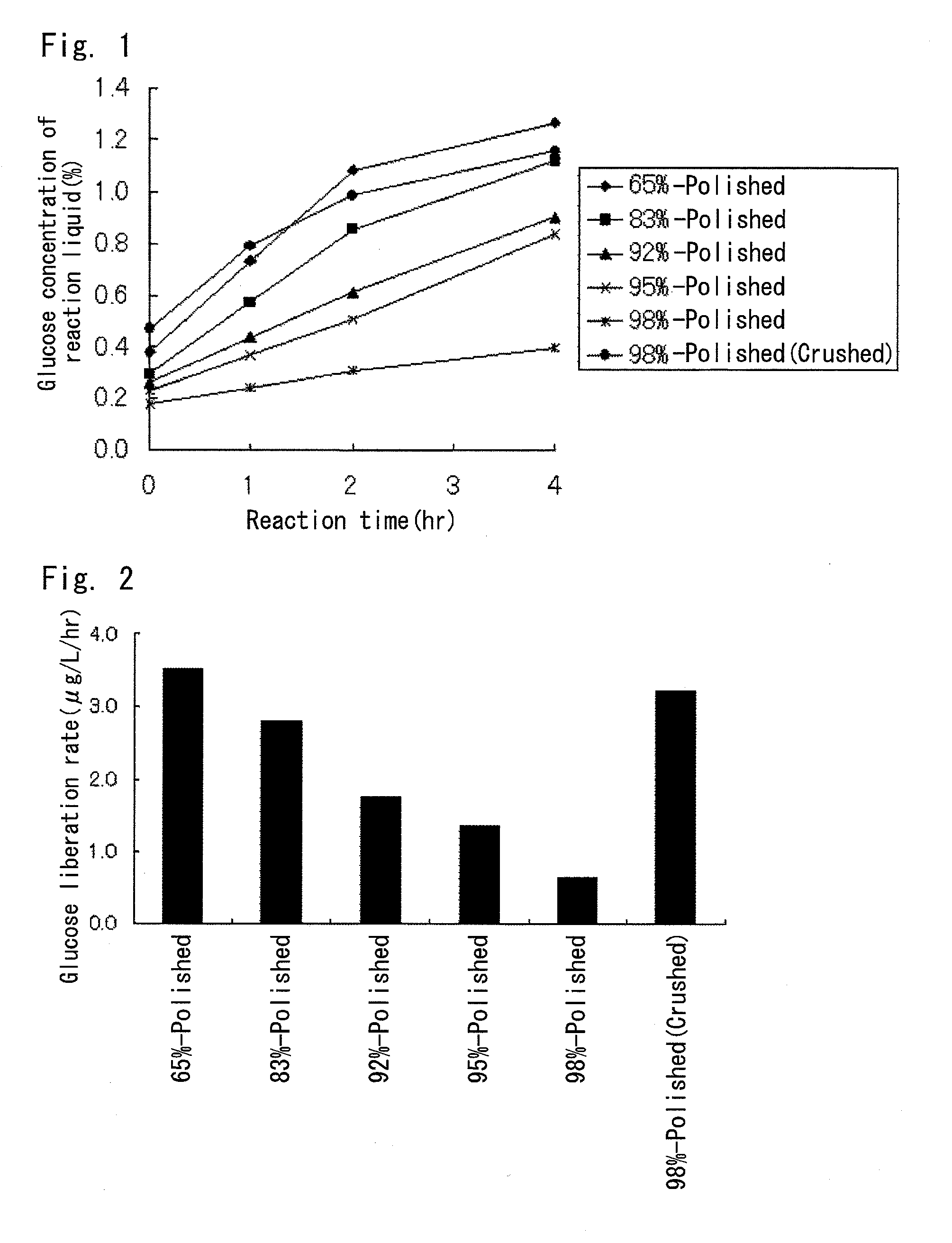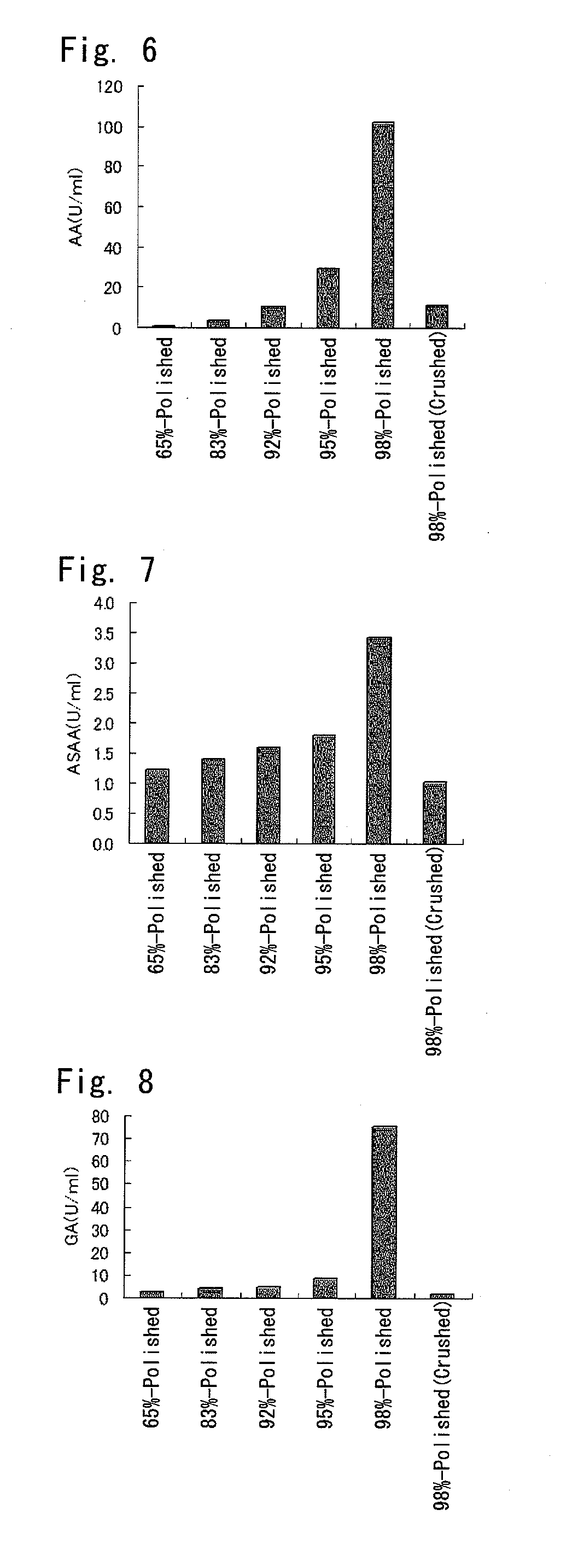Method of producing filamentous fungus culture product
a technology of filamentous fungus and culture product, which is applied in the field of producing can solve the problems of insufficient enzymatic activity of liquid koji, unsuitable for large-scale production, and insufficient saccharification ability of rhizopus, etc., and achieves the adjustment of enzymatic productivity of filamentous fungus culture product, low level, and reduced production cost
- Summary
- Abstract
- Description
- Claims
- Application Information
AI Technical Summary
Benefits of technology
Problems solved by technology
Method used
Image
Examples
experimental example 1
[0123]Measurement of glucose liberation rate from barley having various polishing ratios
[0124]Barley (Stirling, made in Australia) having various polishing ratios of from 65% to 98% was allowed to react with enzymes derived from koji mold culture product, and glucose liberation rates from the barley were measured.
[0125]To be specific, 2 g of each of 65%-polished barley, 83%-polished barley, 92%-polished barley, 95%-polished barley, 98%-polished barley and a 98%-polished barley crushed product were weighed out, and each of the weighed materials and 50 ml of water were put in a 200-ml conical flask. This was sterilized with autoclave at 121° C. for 15 minutes to prepare “barley substrate solution”.
[0126]Subsequently, a koji mold culture product produced by using barley (Stirling, made in Australia) as culture raw material was subjected to solid-liquid separation by filtration with filtering paper to obtain “a koji mold culture supernatant”. The method of producing the koji mold cultur...
example 1
Production of White Koji Culture Product Using Barley Having Various Polishing Ratios
[0138]White koji mold culture products were produced by using various degrees of polished barley (Stirling, made in Australia) by the method as described below, and enzymatic activities therein were measured.
[0139]1. Method of Pre-Culture
[0140]8 g of 65%-polished barley and 100 ml of water were put in a 500-ml baffled conical flask, and was sterilized at 121° C. for 15 minutes with autoclave to obtain a pre-culture medium. After cooling, a white koji mold (Aspergillus kawachii NBRC4308) was inoculated at 1×106 / ml into the pre-culture medium and cultured with shaking at 37° C. and 100 rpm for 24 hours to obtain a pre-culture liquid.
[0141]2. Method of Main Culture
[0142]2 g of any one of 65%-polished barley, 83%-polished barley, 92%-polished barley, 95%-polished barley and 98%-polished barley, 0.2 g of potassium nitrate, 0.3 g of potassium dihydrogen phosphate and 100 ml of water were put in a 500-ml b...
example 2
Production of Black Koji Mold Culture Product Using Barley Having Various Polishing Ratios
[0151]Black koji mold culture products were produced by using various degrees of polished barley (Stirling, made in Australia) by the method as described below, and enzymatic activities therein were measured.
[0152]1. Method of Pre-Culture
[0153]8 g of 65%-polished barley and 100 ml of water were put in a 500-ml baffled conical flask, and was sterilized at 121° C. for 15 minutes with autoclave to obtain a pre-culture medium. After cooling, a black koji mold (Aspergillus awamori NBRC4388) was inoculated at 1×106 / ml into the pre-culture medium and cultured with shaking at 37° C. and 100 rpm for 24 hours to obtain a pre-culture liquid.
[0154]2. Method of Main Culture
[0155]2 g of any one of 65%-polished barley, 83%-polished barley, 92%-polished barley, 95%-polished barley and 98%-polished barley, 0.2 g of potassium nitrate, 0.3 g of potassium dihydrogen phosphate and 100 ml of water were put in a 500-...
PUM
| Property | Measurement | Unit |
|---|---|---|
| Volume | aaaaa | aaaaa |
| Volume | aaaaa | aaaaa |
| Volume | aaaaa | aaaaa |
Abstract
Description
Claims
Application Information
 Login to View More
Login to View More - R&D
- Intellectual Property
- Life Sciences
- Materials
- Tech Scout
- Unparalleled Data Quality
- Higher Quality Content
- 60% Fewer Hallucinations
Browse by: Latest US Patents, China's latest patents, Technical Efficacy Thesaurus, Application Domain, Technology Topic, Popular Technical Reports.
© 2025 PatSnap. All rights reserved.Legal|Privacy policy|Modern Slavery Act Transparency Statement|Sitemap|About US| Contact US: help@patsnap.com



